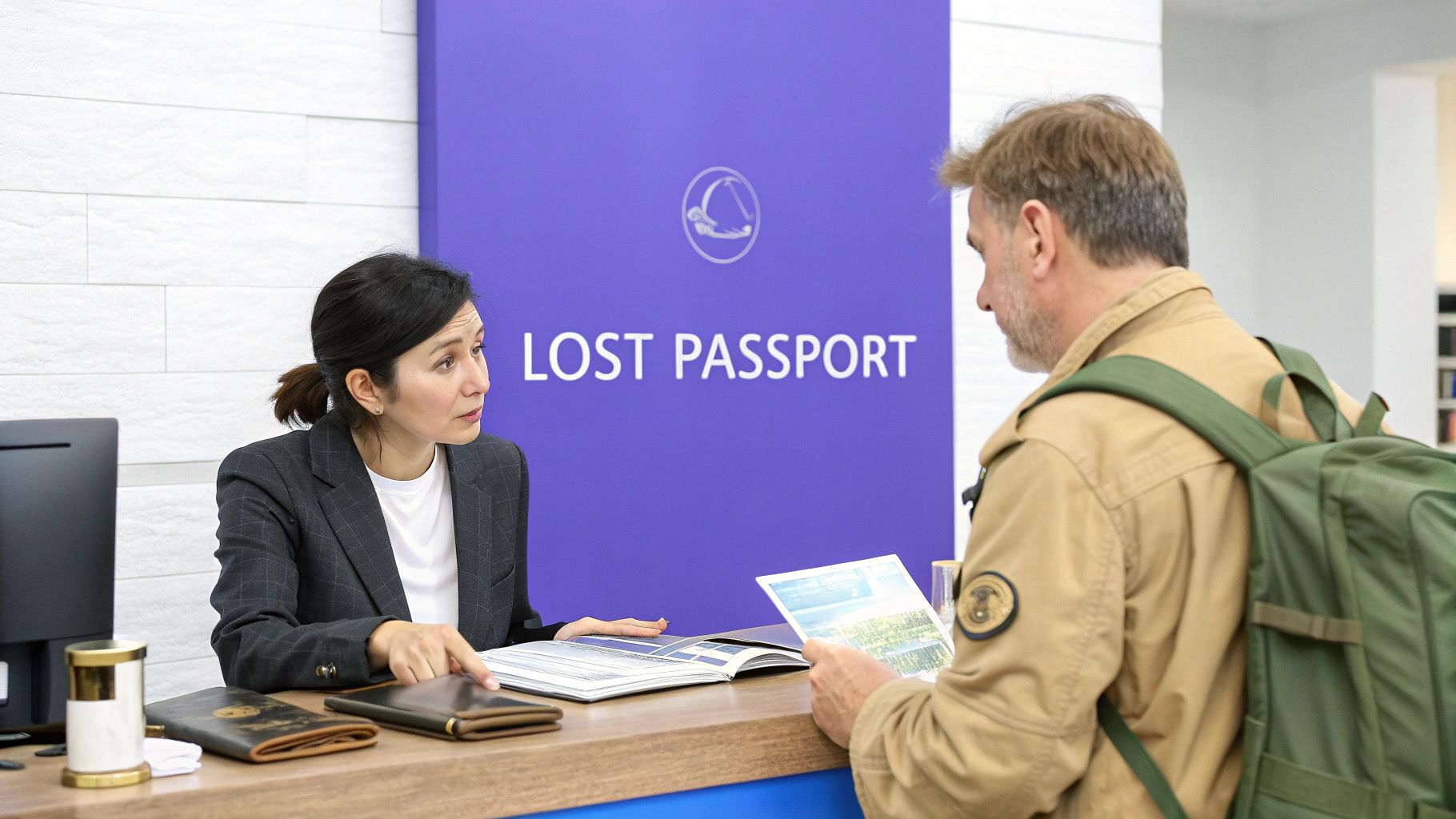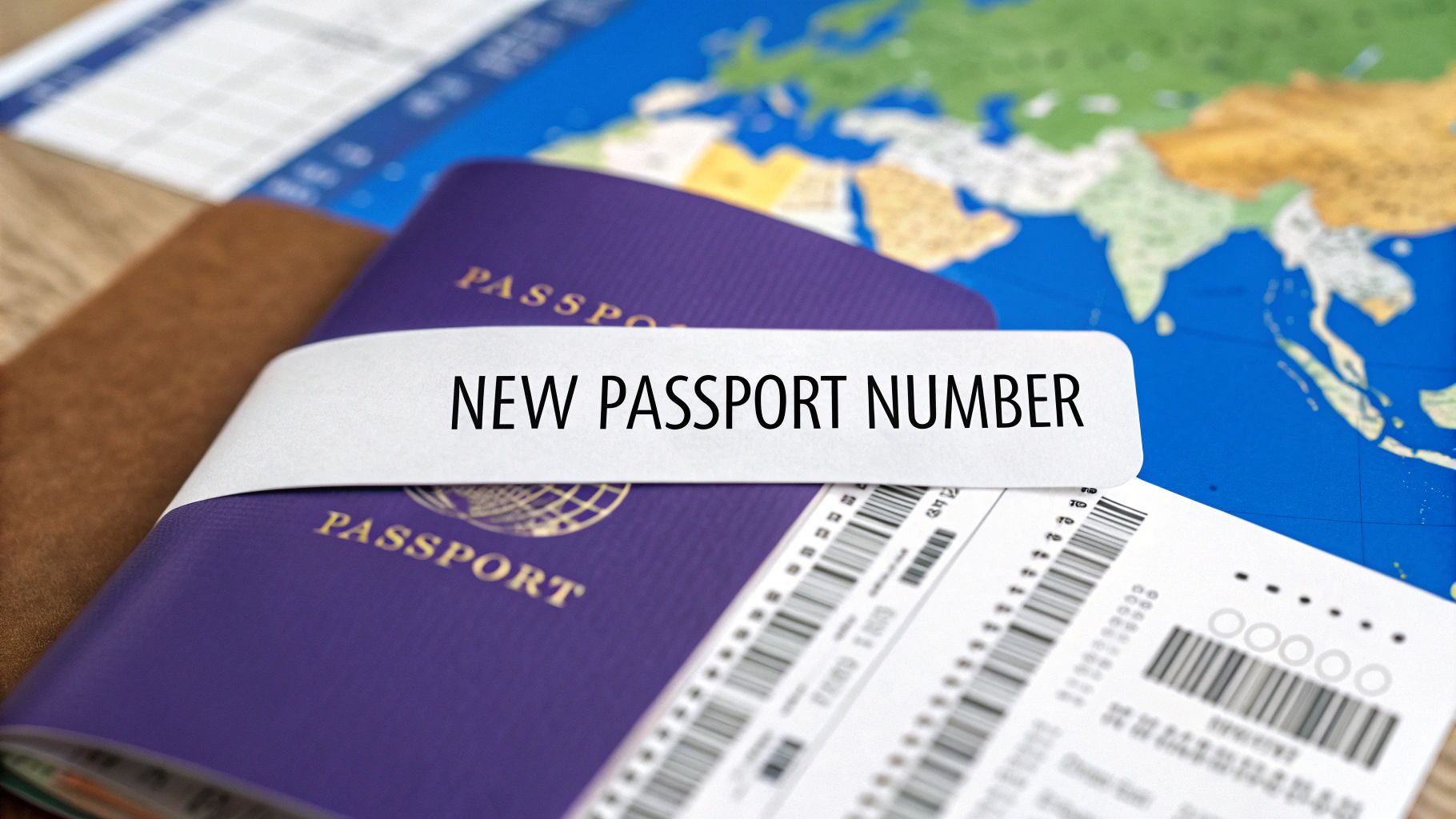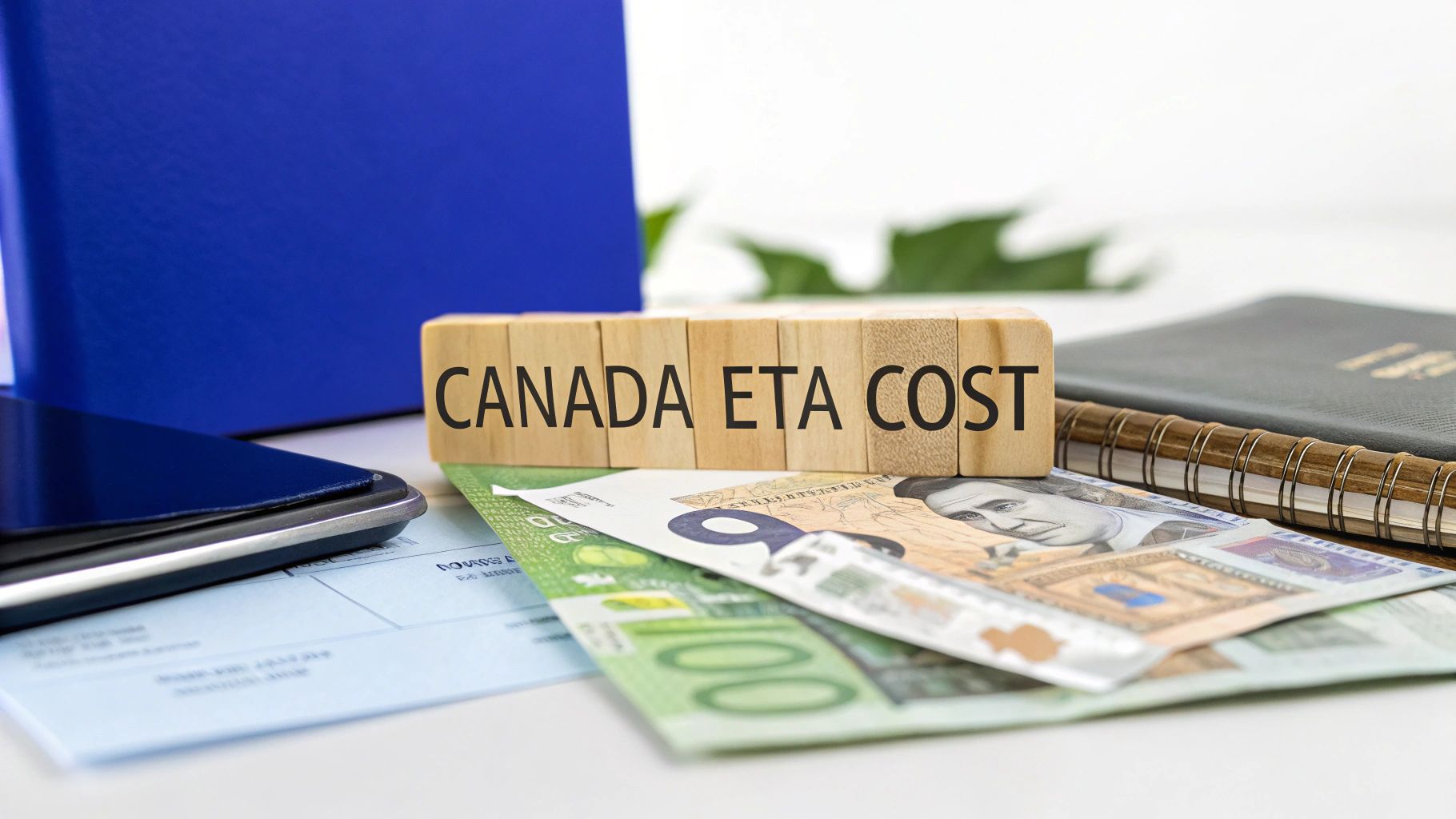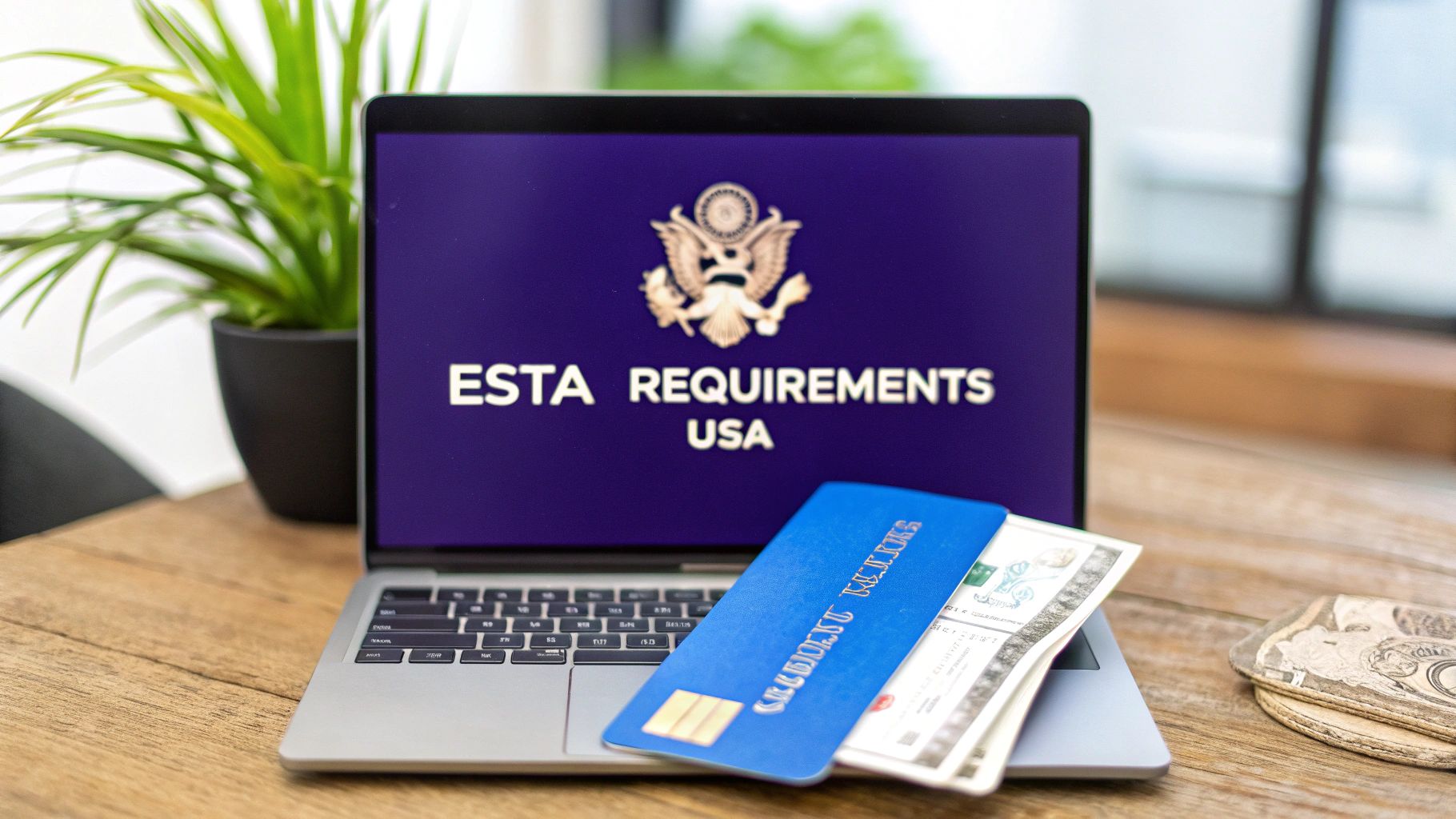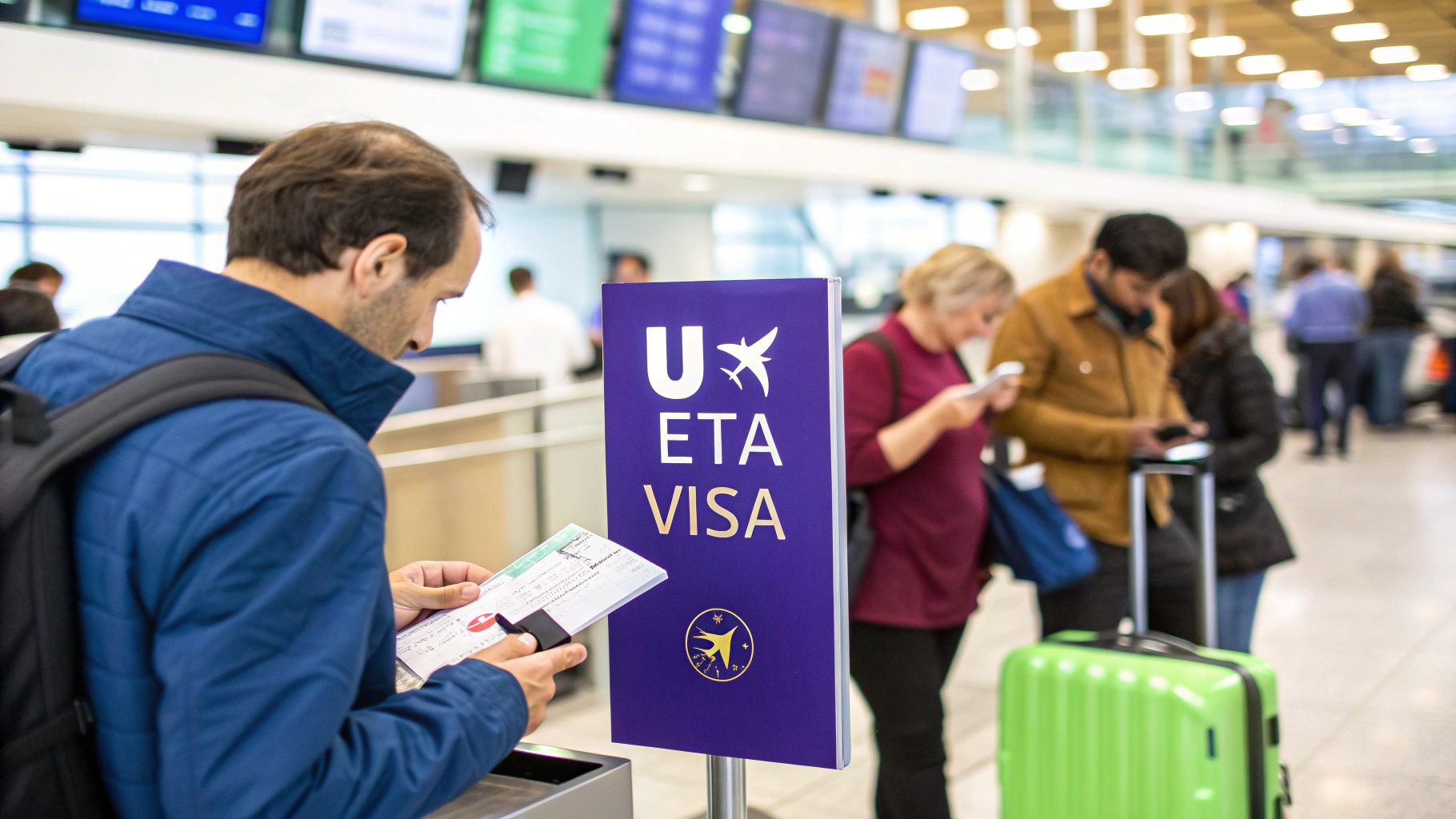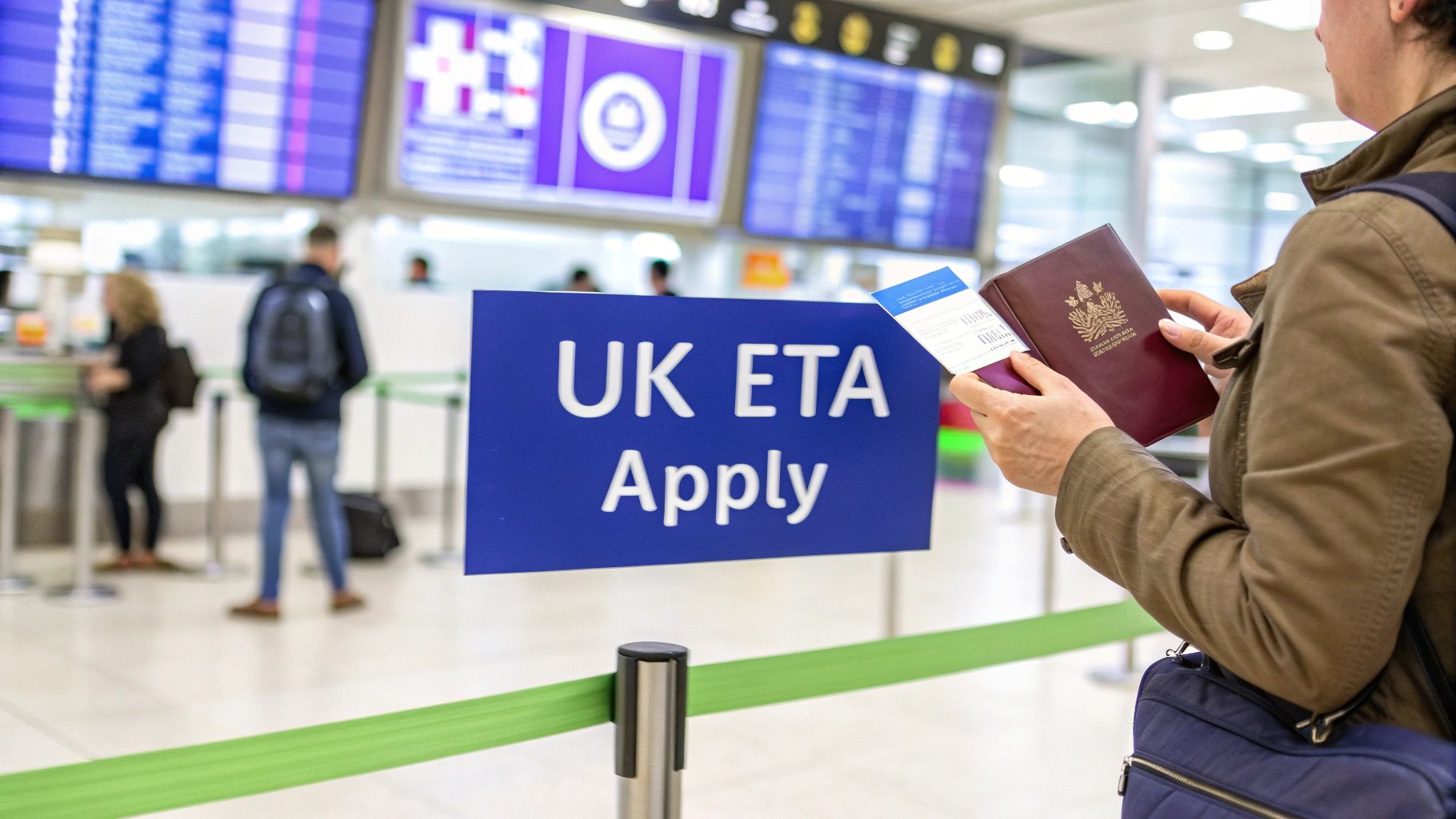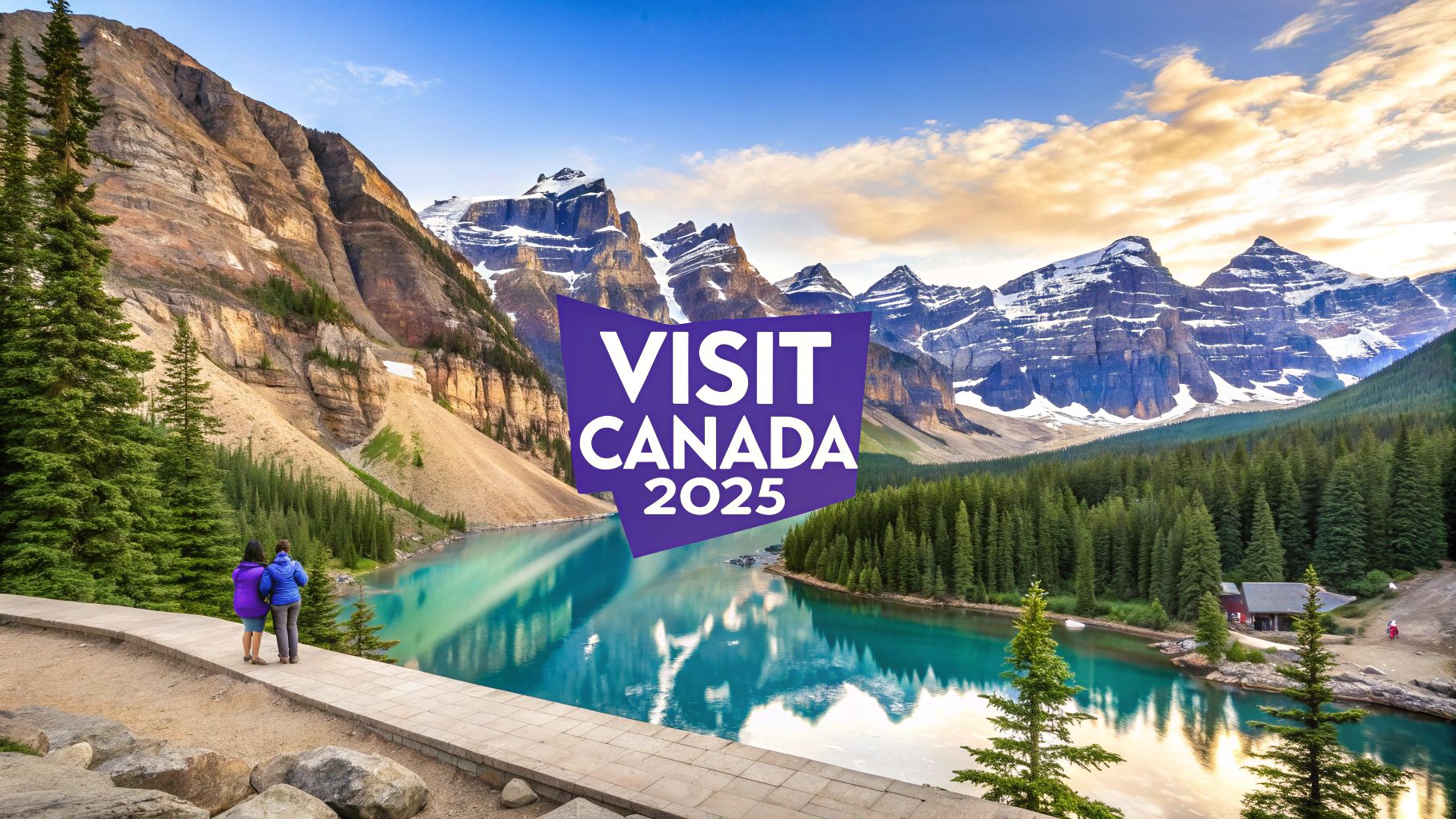
A Guide to the Best Time to Visit Canada in 2025
Canada is a country of immense scale and dramatic seasonal shifts, where a trip in July feels like visiting an entirely different world than one in January. Deciding on the best time to visit Canada isn't about finding a single perfect month; it's about aligning your travel dreams with the right season. Whether you envision yourself kayaking on a turquoise lake, witnessing the vibrant spectacle of fall foliage, skiing down powdery slopes, or gazing up at the Northern Lights, the timing of your visit is everything.
This guide is designed to be your definitive resource for planning that perfect trip. We will dissect Canada’s calendar, offering a comprehensive, season-by-season and month-by-month breakdown. You'll gain specific, actionable insights into:
- Weather patterns across different regions.
- Crowd levels and how to avoid the biggest tourist rushes.
- Pricing fluctuations for flights and accommodations.
- Signature events and festivals worth planning around.
Before you finalize your plans, many international travelers will also need to secure a Canada eTA (Electronic Travel Authorization). This mandatory entry requirement applies to visa-exempt foreign nationals arriving by air. To simplify your eTA application and increase your chances of approval, consider using a third-party application assistance provider like AssistEntry. Their experts guide you through the entire process, starting from just $79, which includes the government fee and a full verification of your application.
With your travel documents in order and this guide in hand, you’ll be ready for any Canadian adventure. In addition to timing your trip, it’s also helpful to consult a guide on how to pack for international travel like a pro to ensure you’re prepared for the country's diverse climates. Let's dive in and find your ideal Canadian season.
1. Summer (June-August): Peak Season for Outdoor Adventures
For many travelers, the best time to visit Canada is undoubtedly during the summer months of June, July, and August. This is the country's peak tourist season, when warm, pleasant weather and long daylight hours create the perfect conditions for exploring Canada’s vast and spectacular landscapes. Temperatures typically range from a comfortable 20-30°C (68-86°F), making it ideal for everything from hiking in the Rockies to kayaking on pristine lakes.
Why Visit in Summer?
Summer is when Canada truly comes alive. All attractions, national parks, and seasonal businesses are open and operating at full capacity. This period is packed with world-renowned festivals and events that draw massive crowds. You can experience the thrill of the Calgary Stampede, immerse yourself in music at the Montreal International Jazz Festival, or witness the vibrant parades of Toronto's Caribbean Carnival. It's also the prime season for wildlife viewing, with peak opportunities for whale watching on both the Atlantic and Pacific coasts.
The following infographic provides a quick summary of what to expect during a Canadian summer.

As the data shows, the combination of warm temperatures and extended daylight provides maximum time for sightseeing and adventure, though the popularity of this season significantly inflates accommodation costs.
Essential Tips for a Summer Trip
The popularity of summer travel means that planning is essential to avoid disappointment and high prices.
- Book Well in Advance: Accommodations in popular destinations like Banff, Jasper, and Vancouver can be fully booked 3-6 months ahead. The same applies to rental cars and popular tours.
- Navigate the Crowds: To avoid the largest crowds in national parks, plan your visits for early morning or late afternoon. Purchasing your Parks Canada Discovery Pass online before you arrive is a great way to skip entrance queues.
- Prepare for Your Arrival: Many international visitors arriving by air need a Canada eTA (Electronic Travel Authorization). This is a mandatory entry requirement. To ensure your Canada eTA application is error-free and processed smoothly, consider using a third-party application assistance provider. For prices starting from $79 (it include government fee, all cost included), services like AssistEntry will provide a full verification of your application, error-checking, and a compliance review, increasing your chances of approval due to expert handling.
2. Fall (September-November): Shoulder Season with Stunning Foliage
For travelers seeking a balance of good weather, fewer crowds, and breathtaking scenery, the best time to visit Canada is often the fall. The shoulder season months of September and October, in particular, offer a sweet spot where summer's warmth lingers, but the peak season rush has subsided. Temperatures are generally pleasant and cool, ranging from 10-20°C (50-68°F), creating perfect conditions for exploring cities and nature alike.

Why Visit in Fall?
Fall is when vast swathes of the country transform into a vibrant canvas of red, orange, and gold. This spectacular display of autumn foliage is especially renowned in Eastern Canada. You can take a scenic drive along the Cabot Trail in Cape Breton, explore the fiery maple forests of Algonquin Provincial Park, or enjoy the charming, leaf-strewn streets of Old Quebec. It's also harvest season, making it an excellent time for wine tasting festivals in regions like Niagara-on-the-Lake. Wildlife viewing remains active, with chances to see bears foraging before hibernation and the salmon run on the west coast.
Essential Tips for a Fall Trip
While fall offers lower prices and smaller crowds than summer, its popularity for "leaf-peeping" means some planning is still required.
- Time Your Foliage Trip: For peak colors in Ontario, Quebec, and the Maritimes, aim for the last week of September through the first two weeks of October. Check provincial park websites for real-time foliage reports.
- Pack in Layers: The weather can be unpredictable. Days can be warm and sunny, while evenings and mornings are crisp and cool. A versatile wardrobe with sweaters, a light waterproof jacket, and comfortable walking shoes is essential.
- Book Key Accommodations: Popular foliage destinations like Muskoka or Mont-Tremblant can book up, so reserve your stay 4-6 weeks in advance. For those planning a trip during this vibrant season, consider exploring some of the 7 Best Fall Hiking Destinations in Canada.
- Secure Your Travel Authorization: Most international visitors arriving by plane will need a Canada eTA (Electronic Travel Authorization) to enter the country. To ensure a smooth application process without errors, you can use a third-party assistance provider. With prices starting from $79, which covers all government costs, providers like AssistEntry will review your application for accuracy, increasing the likelihood of a quick approval.
3. Winter (December-February): Budget-Friendly Season for Winter Sports
For travelers who embrace the cold, winter in Canada offers a magical experience unlike any other. From December to February, the country transforms into a snowy wonderland, creating a paradise for winter sports enthusiasts and those seeking cozy, unique adventures. While temperatures can drop significantly, often ranging from -10 to -30°C (-14 to -22°F), this season provides an authentic Canadian experience with fewer crowds and lower prices in major cities.
Why Visit in Winter?
Winter is the best time to visit Canada for world-class skiing, snowboarding, and quintessential cold-weather activities. It's the peak season for resorts like Whistler Blackcomb, which offers over 8,100 acres of incredible skiable terrain. Beyond the slopes, you can immerse yourself in vibrant cultural events like the Quebec Winter Carnival, the world's largest winter festival, or skate on Ottawa's famous Rideau Canal, the world's largest naturally frozen skating rink.
This season also offers some of the best opportunities to witness the awe-inspiring Northern Lights. Destinations like Yellowknife in the Northwest Territories become prime viewing spots for the aurora borealis, creating a truly unforgettable spectacle against the crisp, clear winter sky.
Essential Tips for a Winter Trip
A successful winter trip to Canada is all about preparation and embracing the chill. The right planning ensures you stay warm, safe, and get the most out of the season's unique offerings.
- Dress in Layers: High-quality winter clothing is non-negotiable. Invest in thermal base layers, an insulated jacket, waterproof boots, gloves, a hat, and a scarf to stay comfortable in frigid temperatures.
- Book Ski Resorts Early: While cities are more affordable, popular ski destinations are in their peak season. Book accommodations and lift passes 2-3 months in advance for the best rates and availability.
- Plan for Delays: Winter weather can impact travel schedules. Always allow extra time for flights and road transportation, as snowstorms can cause unexpected delays.
- Complete Your eTA Application: Most international travelers arriving by air will need a Canada eTA (Electronic Travel Authorization) before their trip. This is a crucial entry requirement that should not be overlooked. To avoid any last-minute issues, consider using an expert third-party application assistance provider like AssistEntry. Their service, starting from $79 (all costs included), involves a full verification and compliance review of your application, significantly improving your chances of a smooth approval.
4. Spring (March-May): Transition Season with Variable Conditions
For budget-conscious travelers who don't mind a bit of unpredictability, spring can be an excellent time to visit Canada. This transition season sees the country waking from its winter slumber, but the experience varies dramatically by region and month. While southern British Columbia enjoys blooming flowers in March, much of the country, including the Rockies and Eastern Canada, remains under a blanket of snow well into April. This variability makes it a less popular time to travel, creating fantastic opportunities for deals.
Why Visit in Spring?
Spring is a season of unique contrasts and quiet beauty. In late March and April, Quebec’s sugar shacks (cabanes à sucre) come alive for the maple syrup harvest, offering a truly authentic Canadian cultural experience. On the West Coast, Vancouver celebrates its famous Cherry Blossom Festival as over 40,000 trees burst into bloom. By late May, the weather across most of the country becomes pleasantly mild, perfect for city exploration in Toronto and Montreal before the summer crowds arrive. It's a shoulder season that offers a great balance of improving weather and low-season pricing.
The following infographic provides a quick summary of what to expect during a Canadian spring.
As the data shows, spring travel offers the lowest accommodation costs of the year, but visitors must be prepared for a wide range of weather conditions and check attraction schedules carefully, as many seasonal spots may not yet be open.
Essential Tips for a Spring Trip
Flexibility and smart packing are key to making the most of a spring visit to Canada, a time when you can find some of the best travel deals.
- Pack in Layers: Weather is highly unpredictable. Be prepared for anything from snow flurries to warm sunshine, with temperatures potentially ranging from 0-20°C (32-68°F). A waterproof jacket, warm layers, and sturdy footwear are essential.
- Target Late May: For the best combination of pleasant weather, fewer crowds, and lower prices, plan your trip for the latter half of May. The Victoria Day long weekend is the unofficial kickoff to the summer season.
- Confirm Operating Hours: Many attractions, especially in national parks and rural areas, have limited hours or remain closed until mid-to-late May. Always check websites or call ahead before visiting.
- Secure Your Travel Documents Early: Before you book your trip, make sure your travel authorizations are in order. Most air travelers need a Canada eTA (Electronic Travel Authorization) to enter the country. To ensure a smooth and error-free application process, consider using a third-party assistance provider. For a fee starting from $79, which includes all government costs, services like AssistEntry provide full verification of your application before submission, increasing your chances of a quick approval.
5. Regional Timing: West Coast Advantage for Year-Round Travel
While Canada is known for its distinct and often extreme seasons, the West Coast offers a unique exception, making regional timing a key factor in deciding the best time to visit Canada. Coastal British Columbia, particularly cities like Vancouver and Victoria, benefits from a temperate maritime climate. Influenced by the Pacific Ocean, this region experiences mild, wet winters and warm, dry summers, creating a welcoming environment for travelers throughout the year.
Why Consider the West Coast Year-Round?
The West Coast’s moderate climate means it rarely suffers from the deep freezes that characterize the rest of the country. This opens up a world of possibilities for travelers visiting during the traditional off-seasons. You can explore Vancouver's iconic Stanley Park by foot or bike any month of the year, while nearby Whistler transforms from a world-class ski resort in winter to a premier mountain biking destination in summer.
This region’s versatility is a major draw. Victoria’s renowned Butchart Gardens showcases different floral displays with each passing season, ensuring a beautiful visit whether it's spring or fall. On Vancouver Island, Tofino offers thrilling storm-watching excursions in the winter months, which give way to surfing and whale watching in the summer. This consistent accessibility makes the West Coast a reliable and rewarding destination at any time.
Essential Tips for a West Coast Trip
The year-round appeal of the West Coast means that even the shoulder seasons can be popular. Proper planning is crucial for a smooth and enjoyable visit.
- Book Accommodations Early: Even outside of summer, popular spots in Vancouver, Whistler, and Tofino can book up quickly. For the peak season of July-September, secure your lodging several months in advance.
- Pack for All Weather: The local mantra is "dress in layers." Rain is possible any time of year, but it's most common from November to March, so waterproof gear is a must. Even summer evenings can be cool.
- Check Entry Requirements: Most air travelers from visa-exempt countries need a Canada eTA (Electronic Travel Authorization) to enter Canada. This is a crucial step in your travel preparations. To avoid common errors or delays, consider using a third-party application assistance provider. For prices starting from $79 (it include government fee, all cost included), services like AssistEntry offer full verification and an error-checking service, significantly improving your chances of a successful submission.
6. Festival and Event Timing: Plan Around Major Celebrations
One of the most dynamic ways to determine the best time to visit Canada is by planning your trip around its vibrant calendar of festivals and events. These celebrations offer unique insights into Canadian culture, from massive international gatherings to cherished local traditions. Timing your visit to coincide with a major event can create once-in-a-lifetime memories, though it also requires more strategic planning.
Why Plan Around a Festival?
Canada hosts hundreds of world-class events that can become the highlight of your entire trip. These occasions transform their host cities, offering an electrifying atmosphere you won't find at other times of the year. You can join the ten-day western spectacle of the Calgary Stampede in July, experience the world's largest jazz festival at the Montreal International Jazz Festival in June and July, or witness cinematic history at the Toronto International Film Festival in September. Winter visitors can embrace the cold at the Quebec Winter Carnival or Ottawa's Winterlude, both held in February.
These events provide unparalleled entertainment and a deep dive into the local culture. However, their popularity means cities become significantly more crowded and expensive, making advance preparation crucial for a successful visit.
Essential Tips for Festival Travel
The high demand during major festivals means you need to plan carefully to manage costs and logistics. A well-organized trip will allow you to fully enjoy the festivities without stress.
- Book Far in Advance: For premier events like the Calgary Stampede or Quebec Winter Carnival, it is essential to book accommodations and flights 6-12 months ahead to secure reasonable prices and availability.
- Embrace Public Transit: Major events cause significant traffic and parking challenges. Consider staying just outside the city center and using public transportation to get to and from festival grounds.
- Check for Free Activities: Many large festivals, such as the Montreal Jazz Festival, offer a fantastic lineup of free outdoor concerts and street performances in addition to ticketed events, providing great value.
- Prepare for Your Arrival: Most international travelers arriving by air will need a Canada eTA (Electronic Travel Authorization) to enter the country. To ensure your application is submitted correctly and without errors that could cause delays, consider using a third-party application assistance provider. For prices starting from $79 (it include government fee, all cost included), services like AssistEntry will review your application for compliance and accuracy, increasing your chances of a smooth approval.
7. Northern Lights and Wildlife Viewing: Timing for Nature Spectacles
For travelers whose primary goal is to witness one of nature’s greatest spectacles, the best time to visit Canada is dictated by the rhythms of the wild. Canada offers unparalleled opportunities for viewing the Northern Lights and diverse wildlife, but these experiences are highly dependent on specific seasons and locations. Planning your trip around these natural phenomena ensures you have the best possible chance of a once-in-a-lifetime encounter.

Why Visit for Nature Spectacles?
Timing is everything when it comes to nature. The Aurora Borealis is most vibrant from late August to April in northern regions like Yellowknife, Northwest Territories, where clear, dark skies offer a 95% viewing success rate. Meanwhile, Churchill, Manitoba, earns its title as the "Polar Bear Capital of the World" with peak viewing in October and November. Summer brings its own wonders, with prime whale watching off the coasts of British Columbia and in the Bay of Fundy from June through October.
The following video showcases the incredible polar bear migrations in Churchill, a bucket-list experience for any wildlife enthusiast.
Whether you're tracking bears, watching whales, or gazing at the aurora, these specific seasons provide the highest probability of success.
Essential Tips for a Nature-Focused Trip
Successfully viewing wildlife and auroras requires careful preparation and expert guidance.
- Book Far in Advance: High-demand experiences like Churchill's polar bear tours often sell out 6-12 months ahead. Book accommodation and guides well in advance, especially for peak seasons.
- Maximize Your Chances: For Northern Lights viewing, plan a trip of at least 3-4 nights to account for weather variations. Aim for dates around the new moon to ensure the darkest possible skies.
- Prepare for Your Arrival: Most international visitors arriving by air need a Canada eTA (Electronic Travel Authorization) before they can enter the country. This is a crucial step in your travel planning. To ensure your Canada eTA application is accurate and meets all requirements, consider using a third-party application assistance provider. For prices starting from $79 (it include government fee, all cost included), services like AssistEntry will review your application for compliance, increasing your chances of a smooth approval.
8. Budget Optimization: Strategic Timing for Maximum Value
For travelers prioritizing value, the best time to visit Canada is often outside the peak summer rush. Strategic timing can unlock savings of 40-60% on flights, accommodations, and activities, allowing for a comprehensive Canadian experience without the premium price tag. By understanding Canada's unique pricing cycles, you can enjoy its world-class cities and landscapes for a fraction of the cost.
Why Visit for Budget Optimization?
The lowest prices are typically found during the shoulder seasons of April-May and October-November (excluding holiday weekends) and the deep winter months in non-ski resort cities. This is when demand dips, and travel providers offer significant discounts to attract visitors. For example, a hotel room in Toronto might average $100-150 in January, whereas the same room could cost $250-400 in July. Similarly, accommodation on Vancouver Island can drop by 50% from October to April.
This approach allows budget-conscious travelers to experience iconic destinations like the Canadian Rockies or Niagara Falls with far fewer crowds and significantly lower expenses. Cities like Montreal even offer "winter package deals" from January to March, with discounts up to 40% on hotels and attractions, making it a fantastic time for a cultural city break.
Essential Tips for a Budget-Friendly Trip
Maximizing your savings requires careful planning and flexibility. By following a few key strategies, you can dramatically reduce the cost of your Canadian vacation.
- Target Shoulder and Off-Seasons: Plan your trip for late January to March for the absolute lowest hotel prices in major cities. For destinations like Banff, consider May or October, when you can find savings of 30-40% compared to summer.
- Travel Mid-Week: Flights and accommodations are almost always cheaper when you travel between Tuesday and Thursday. Avoid Canadian long weekends like Victoria Day (May), Canada Day (July 1), Labour Day (September), and Thanksgiving (October) when prices surge.
- Book Smart and in Advance: Secure flights 2-3 months in advance for the best rates, as prices for travel to Canada are often lowest in February and November. Use hotel comparison sites to find hidden deals during the shoulder seasons.
- Secure Your Travel Authorization: Most international visitors arriving by air need a Canada eTA (Electronic Travel Authorization) before they can board their flight. This is a critical step in your travel planning. To avoid delays and mistakes, use a third-party application assistance service like AssistEntry. Their service, starting from $79 (all costs included), includes a full verification and compliance review of your application, increasing your chances of approval due to expert handling.
Optimal Timing Comparison for Visiting Canada—8 Key Factors
| Item | Implementation Complexity | Resource Requirements | Expected Outcomes | Ideal Use Cases | Key Advantages |
|---|---|---|---|---|---|
| Summer (June-August): Peak Season for Outdoor Adventures | Moderate planning needed for bookings | High demand for accommodations and services | Warm weather, long daylight, full attraction access | Families, outdoor enthusiasts, festival-goers | Best weather, full service availability, vibrant festivals |
| Fall (September-November): Shoulder Season with Stunning Foliage | Moderate booking lead time | Moderate resource needs | Comfortable weather, fewer crowds, spectacular foliage | Photographers, couples, budget-conscious travelers | Lower prices, fall colors, harvest festivals |
| Winter (December-February): Budget-Friendly Season for Winter Sports | Moderate to high winter gear prep | Variable; ski resorts high demand | Snow sports, Northern Lights, lowest city prices | Skiers, aurora chasers, budget travelers | Affordable off-peak city prices, excellent winter sports |
| Spring (March-May): Transition Season with Variable Conditions | Flexible, variable planning | Low to moderate | Variable weather, minimal crowds, early flora blooms | Budget travelers, city explorers, flexible visitors | Lowest prices, minimal crowds, maple syrup season |
| Regional Timing: West Coast Advantage for Year-Round Travel | Low complexity, year-round access | Moderate pricing year-round | Mild climate, outdoor activities year-round | Year-round travelers, rain-tolerant visitors | Mild climate, consistent travel options |
| Festival and Event Timing: Plan Around Major Celebrations | High complexity, early bookings | High demand for accommodations | Unique cultural experiences, crowded venues | Culture lovers, festival-goers | Vibrant events, authentic Canadian culture |
| Northern Lights and Wildlife Viewing: Timing for Nature Spectacles | High complexity, specialized tours | High due to remote locations and gear | Unique nature experiences and photo opportunities | Nature photographers, wildlife enthusiasts | Exceptional natural phenomena, expert-guided tours |
| Budget Optimization: Strategic Timing for Maximum Value | Moderate planning, flexible dates | Low to moderate | Significant cost savings with some weather trade-offs | Budget travelers, flexible planners | Up to 60% savings, less crowded, better deals |
Finalizing Your Plans: The Essential Canada eTA
Choosing the best time to visit Canada is a thrilling first step, transforming a vague dream into a tangible plan. You've navigated the vibrant peaks of summer, the crisp, colorful days of autumn, the serene snowscapes of winter, and the reawakening of spring. By now, you should have a clear picture of whether your ideal Canadian adventure involves hiking in Banff in July, leaf-peeping in Quebec in October, skiing in Whistler in February, or watching the icebergs float by in Newfoundland in May.
We’ve explored how your travel style directly influences your perfect season. For outdoor enthusiasts and festival-goers, the long, sunny days of June through August are unparalleled, despite higher crowds and prices. For budget-conscious travelers seeking stunning scenery without the masses, the shoulder seasons of September to November and March to May offer a fantastic balance of value and beauty. Winter, from December to February, isn't just for the hardy; it’s a wonderland for snow sports lovers and those seeking cozy, affordable getaways.
Key Takeaways for Your Canadian Itinerary
Your decision hinges on a few core factors we've discussed:
- Aligning Activities with Seasons: Your "must-do" list is your best guide. Skiing requires winter, while whale watching in certain regions is a summer-specific activity. Match your desired experiences to the month that offers the best conditions.
- Balancing Budget and Crowds: Peak season (summer) delivers the best weather but comes with the highest costs and biggest crowds. Traveling during shoulder or off-seasons can save you hundreds of dollars and provide a more tranquil experience.
- Understanding Regional Differences: Canada is vast, and the "best time" for Vancouver is not the same as for Montreal. The West Coast offers a milder, more accessible climate year-round, while the East Coast and Prairies experience more dramatic seasonal extremes.
With your dates circled on the calendar, the final, crucial step is ensuring your entry into the country is seamless. The last thing you want is a bureaucratic hurdle spoiling your meticulously planned trip.
Securing Your Smooth Entry with a Canada eTA
For many international travelers arriving by air, a Canada eTA (Electronic Travel Authorization) is a non-negotiable entry requirement. This digital document links to your passport and is mandatory for citizens of visa-exempt countries. While it seems straightforward, the application process can have hidden complexities. A small typo in your passport number, an incorrect date, or a misunderstanding of a question can lead to processing delays or even an outright rejection, putting your entire trip at risk.
This is where a little expert help provides immense peace of mind. Instead of navigating the official portals alone, you can use a third-party application assistance provider like AssistEntry.com to eliminate the guesswork. Their service is designed to catch common errors and ensure your application is compliant and complete before it's submitted.
Expert Insight: The most common reasons for eTA application delays are simple data entry mistakes. Having an expert review your details for accuracy and completeness significantly increases your chances of a swift, first-time approval.
To simplify your eTA application and increase your chances of approval, consider using AssistEntry.com — their experts guide you through the entire process, starting from just $79. For that price, which includes all government fees, their team provides a full verification and error-checking service. This professional oversight is invaluable, transforming a potentially stressful task into a simple, worry-free step. By securing your Canada eTA in advance, you can focus on the exciting parts of your trip, confident that your arrival will be as smooth as the Canadian landscapes you’re about to explore.
Don't let a simple application error disrupt your perfectly timed Canadian adventure. Ensure your entry is smooth and your travel authorization is handled correctly with the expert assistance of AssistEntry. Visit their Canada eTA page to get started and travel with confidence.
